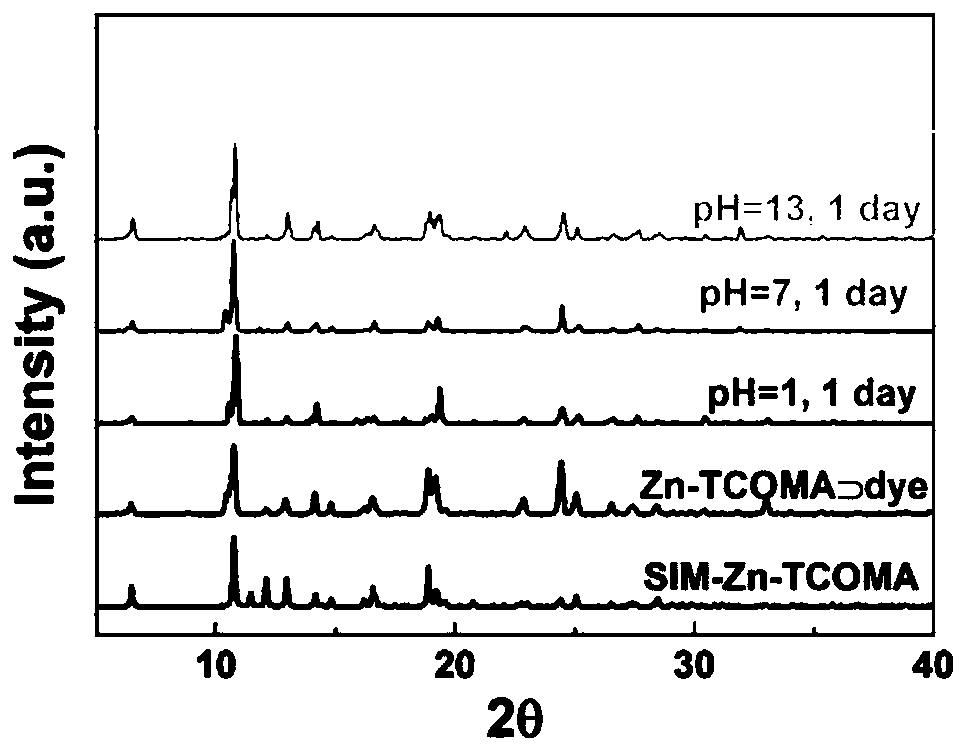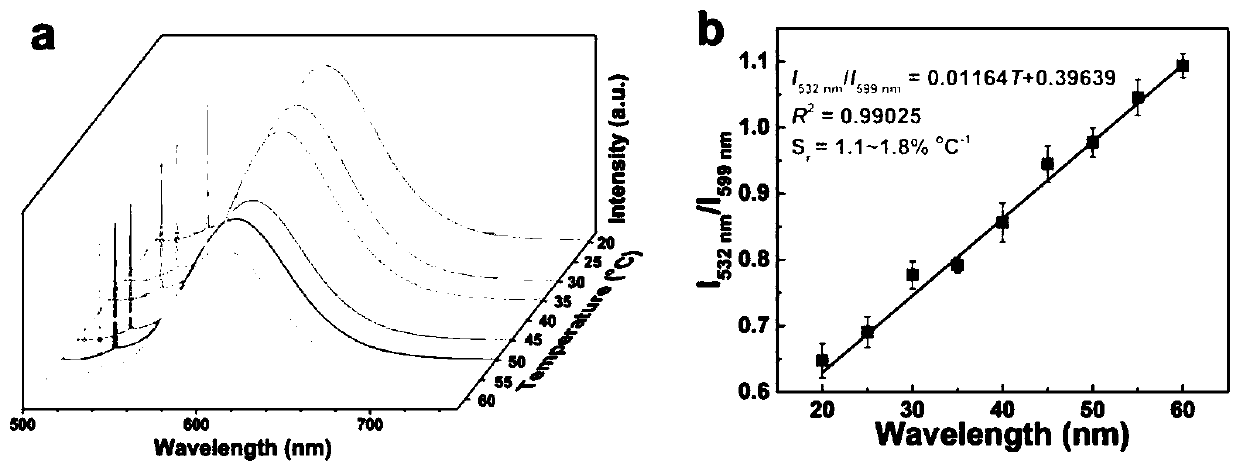Dye/metal-organic framework composite material with second-order and third-order nonlinear optical properties and preparation method and application thereof
A third-order non-linear, optical performance technology, applied in the field of dyes/gold, can solve the problems of inapplicability, achieve the effects of increasing biocompatibility, avoiding fluorescence quenching, and improving luminous efficiency
- Summary
- Abstract
- Description
- Claims
- Application Information
AI Technical Summary
Problems solved by technology
Method used
Image
Examples
Embodiment 1
[0033] Synthesis of metals by solvothermal method using zinc nitrate and 4,4'-[[2,2-bis[(4-carboxyphenoxy)methyl]-1,3-propanediyl]bis(oxy)benzoic acid -Organic framework material, its specific synthetic route is as follows:
[0034] 1mmol of zinc nitrate and 1mmol of 4,4'-[[2,2-bis[(4-carboxyphenoxy)methyl]-1,3-propanediyl]bis(oxy)benzoic acid, 15mg cation The dye 4-(4-(dimethylamino)styryl)-1-ethylpyridine was dissolved in 4 mL DMF, 4 mL ethanol and 4 mL H 2 O mixed solvent, then the solution was packaged in a 20mL polytetrafluoroethylene reactor, and placed in an oven at 130°C for 5 days. Cool to room temperature and wash with DMF three times to obtain a two-photon dye-containing metal-organic framework material with a dye content of 8.45 wt%.
[0035] Under the excitation of 1064nm laser, the peak of the obtained emission spectrum is located at 532,599nm. As the temperature increases, the intensity ratio increases ( image 3 ). It can be fitted with the following formul...
Embodiment 2
[0043] Using zinc nitrate and 4',4"-[[2,2-bis[(4'-carboxy[1,1'-biphenyl]-4-yl)oxy]methyl]-1,3-propanediol] Bis(oxygen)]-bis-[1,1'-biphenyl]-4-carboxylic acid is used to synthesize metal-organic framework materials by solvothermal method, and its specific synthetic route is as follows:
[0044] 1 mmol of zinc nitrate and 1 mmol of 6,6'-[[2,2-bis[(6-carboxy-2-naphthyl)oxy]methyl]-1,3-propanediol]bis(oxygen)]-bis -2-Naphthoic acid, 15mg cationic dye 4-(4-(dimethylamino)styryl)-1-ethylpyridine dissolved in 4mL DMF, 4mL ethanol and 4mL H 2 O mixed solvent, then the solution was packaged in a 20mL polytetrafluoroethylene reactor, and placed in an oven at 130°C for 5 days. After cooling to room temperature, washing with DMF three times, the metal-organic framework material containing two-photon dye was obtained.
[0045] When the material is excited by a 1064nm laser, the peak of the emission spectrum is located at 532,599nm, and the intensity ratio increases with the increase of t...
PUM
| Property | Measurement | Unit |
|---|---|---|
| Sensitivity | aaaaa | aaaaa |
Abstract
Description
Claims
Application Information
 Login to View More
Login to View More - R&D
- Intellectual Property
- Life Sciences
- Materials
- Tech Scout
- Unparalleled Data Quality
- Higher Quality Content
- 60% Fewer Hallucinations
Browse by: Latest US Patents, China's latest patents, Technical Efficacy Thesaurus, Application Domain, Technology Topic, Popular Technical Reports.
© 2025 PatSnap. All rights reserved.Legal|Privacy policy|Modern Slavery Act Transparency Statement|Sitemap|About US| Contact US: help@patsnap.com



